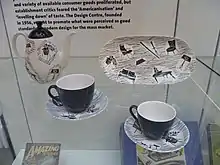
Homemaker was a pattern of mass-produced earthenware tableware that was very popular in the United Kingdom in the 1950s and 60s.[1] The pattern was designed by Enid Seeney[2][3] (2 June 1931 – 8 April 2011),[2] manufactured by Ridgway Potteries of Stoke-on-Trent between 1957 and 1970,[3][1] and sold exclusively through Woolworth's stores.

The pattern was a distinctive black on white featuring illustrations of the latest home furnishings and utensils against a background of irregular black lines. Items illustrated included a boomerang or kidney shaped table, a Robin Day armchair, a Gordon Russell type sideboard, plant holders on legs, tripod lights and lamp shades, and a two seat Sigvard Bernadotte style sofa.[1] Some very curved elements, such as teacups and lids, were plain black.
Production
Tom Arnold gave Enid Seeney a brief to create a modern all-over pattern suitable for production using the Murray Curvex printing machine.[1] The first prototype was a single plate displayed on the Ridgway stand at the 1956 Blackpool trade fair where it attracted little interest.[1] Seeney's original concept was for a high-end porcelain set, with yellow holloware, and had her team create a group of such items, which were displayed in the Ridgway design studio.[1] This prototype coffee set was then noticed by Ted Smith a buyer from Woolworths who placed an order in 1957 for tea sets to be sold in five London stores.[1] Seeney left Ridgway soon after and did not know that the range was being sold throughout Britain until she later spotted it for sale in a branch of Woolworths in Plymouth.[3] The Homemaker range was first produced using the Metro shape created by Ridgway design director Tom Arnold[1] (died 2002) and later on the new Cadenza shape. Homemaker was earthenware, transfer printed with a glaze applied on top, which enabled it to be produced relatively cheaply and to appeal to a mass market. Production of the blank ware was out-sourced to at least one other Staffordshire factory over its life, but pieces were always printed at Ridgway, and marked with one of a range of Ridgway backstamps.[1] In 1959, the American company Homer-Laughlin made unlicensed copies of the design.[1]
Collecting
Because Homemaker was produced in very large quantities over a long period of time, few pieces are rare. The range is, however, highly collectable. A few pieces are scarce and have higher values, such as the Bon Bon Dish and the Cadenza Teapot [1] which may be the rarest item in the range. Items in red on white are also known, and many of the known examples have been sourced in Australia.
References
- 1 2 3 4 5 6 7 8 9 10 11 Moss, Simon (2002). Homemaker : a 1950s design classic (2nd ed.). Moffat, Scotland: Cameron & Hollis. ISBN 0-906506-21-2. OCLC 52144282.
- 1 2 "Designer of iconic pottery tableware dies at 79". The Sentinel. 18 April 2011. Archived from the original on 6 March 2014. Retrieved 20 February 2014.
- 1 2 3 Simon Moss (8 May 2011). "Enid Seeney obituary". The Guardian. Archived from the original on 20 February 2014. Retrieved 20 February 2014. Seeney also designed Samoa and English Garden.
{{cite news}}: CS1 maint: postscript (link)
Further reading
- Moss, Simon. (1997) Homemaker: A 1950s design classic. Moffat: Cameron & Hollis. (2nd revised edition 2002). ISBN 978-0906506219